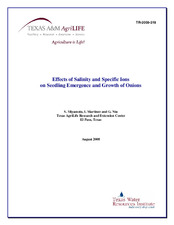| dc.description.abstract | The concentrate from nanofiltration is usually enriched with divalent ions, such as Ca, Mg and SO4. Since divalent ions are less hazardous to soils and plants, it was hypothesized that the disposal of nanofiltration concentrate to irrigation water may not be deleterious, especially for growing crops sensitive to specific effects of Na and/or Cl. This study examined the above hypothesis by observing the effect of salinity and ion composition of irrigation water on seedling emergence, survival and growth of onions. Onions are an important winter crop grown in the Rio Grande Valleys, and are regarded as being sensitive to Cl ions.
Two soil types (Harkey silt loam and Bluepoint loamy sand) were used for a greenhouse experiment involving two onion cultivars ‘BR-1’ and ‘Chaco’. Harkey silt loam had three levels of initial soil salinity (3.9, 2.2 and 0.6 dS m-1). They were placed in pots, seeded and irrigated for 4 ½ months using nine types of saline solutions. The first four solutions had four levels of salinity: 1.0, 1.8, 3.7 and 5.2 dS m-1 (or 630, 1200, 2500 and 3700 ppm) at a constant ionic ratio of 1:1 for Na: Ca + Mg, and Cl: SO4, and other solutions had three levels of ionic concentration ratios; 3:1, 1:1, and 1:3 at fixed levels of salinity, either 20 or 40 me L-1. The last solution was prepared by adding Ca and SO4 at 20 me L-1 to the 2.2 dS m-1 solution. Seedling emergence, survival and growth were measured along with soil salinity, and Na Ca and Cl contents of the plant tissue.
Results have shown that seedling emergence and survival were affected by watering methods and soil types, especially by the initial soil salinity levels, besides salinity of the irrigation solutions. In surface-irrigated loamy sand, seedling emergence and survival were excellent, regardless of the saline solutions used. In surface-irrigated silt loam, seedling emergence was low (< 20%), presumably due to soil crusting. In subirrigated silt loam, seedling emergence and survival were reduced by increasing initial soil salinity and salinity of the irrigation solutions, but not by the ion composition. Seedling growth was also reduced by increasing salinity and Cl/SO4 ratios when Cl concentration exceeded 10 me L-1 in irrigation water. The addition of Ca and SO4 to an irrigation solution (2.2 dS m-1) reduced seedling growth. The tissue Na and, to some extent, Cl concentration increased with increasing Na/(Ca + Mg) ratio in irrigation water. A similar trend was found for the Cl to SO4 ratios, while tissue Ca concentrations remained relatively stable. The Cl concentration of the plant top was higher than that in the roots, when its concentration in the irrigation solution exceeded approximately 10 me L-1.
Although onions were shown to accumulate Cl ions in plant top, the deleterious effect of Cl seems to appear after seedling growth is first curtailed by salinity. The establishment of onion crops are controlled largely by soil salinity, soil types and management practices rather than ionic composition. The application of nanofiltration concentrate to irrigation water inevitably increases salinity, and for this reason, it is unlikely to be beneficial for onion crop production under the prevailing furrow-irrigated conditions of the Rio Grande Valleys. | en |


